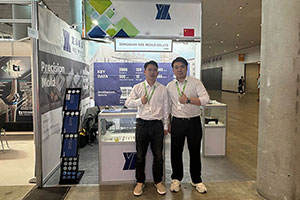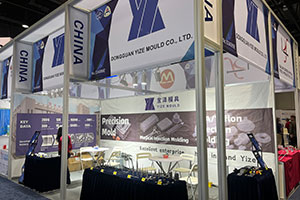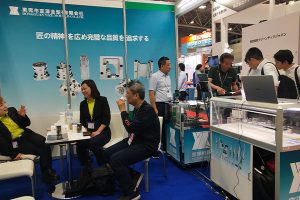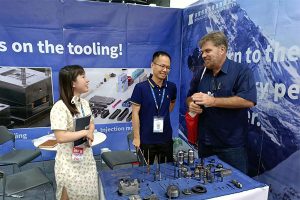Performance Guarantee of Tungsten Carbide Die in High – Temperature Environments
In modern industrial production, tungsten carbide die, as a crucial tool, has a wide range of applications in high – temperature environments. However, high – temperature environments pose significant challenges […]
In modern industrial production, tungsten carbide die, as a crucial tool, has a wide range of applications in high – temperature environments. However, high – temperature environments pose significant challenges to the performance of tungsten carbide die, such as a decrease in hardness, a weakening of wear resistance, and the occurrence of thermal fatigue. Therefore, ensuring the performance of tungsten carbide die in high – temperature environments has become an urgent issue in the industrial sector. This article will systematically explore strategies for guaranteeing the performance of tungsten carbide die in high – temperature environments from the aspects of material selection and optimization, structural design optimization, heat treatment process optimization, lubrication and cooling system optimization, as well as operation and maintenance management.
Material Selection and Optimization
Selection of Tungsten Carbide Materials
In high – temperature environments, the selection of tungsten carbide materials is the foundation for ensuring die performance. High – quality tungsten carbide materials should possess a high melting point, high hardness, high wear resistance, and good thermal stability. Generally, the higher the carbide content in tungsten carbide, the better its hardness and wear resistance, but its thermal stability will correspondingly decrease. Therefore, when selecting tungsten carbide materials, it is necessary to comprehensively consider factors such as hardness, wear resistance, and thermal stability to choose tungsten carbide materials suitable for high – temperature environments.
Unser Fabrikgeschäft: Hartmetallteile, Formteile, medizinische Spritzgussformen, Präzisionsspritzgussformen, Teflon-PFA-Spritzguss, PFA-Rohrverschraubungen. E-Mail: [email protected],whatsapp:+8613302615729.
Material Optimization Treatment
To further enhance the performance of tungsten carbide materials in high – temperature environments, material optimization treatment methods can be adopted. For example, adding modifiers such as rare earth elements and nanoparticles can improve the microstructure and properties of tungsten carbide materials, enhancing their resistance to high – temperature oxidation and thermal fatigue. In addition, using advanced powder metallurgy technology to prepare high – performance tungsten carbide materials can also meet the requirements for use in high – temperature environments.
Structural Design Optimization
Reducing Thermal Stress
In high – temperature environments, significant thermal stress will be generated inside the tungsten carbide die, which is likely to cause die deformation and cracking. To reduce thermal stress, reasonable structural designs can be adopted, such as using a symmetric structure and increasing the fillet radius. At the same time, optimizing the die’s cooling system to reduce the temperature gradient of the die can also effectively reduce thermal stress.
Improving Heat Dissipation Performance
Improving the heat dissipation performance of tungsten carbide die is crucial for ensuring its high – temperature performance. The heat dissipation performance can be enhanced by increasing the heat dissipation area and optimizing the heat dissipation structure. For example, machining heat dissipation grooves and heat dissipation holes on the surface of the die can increase the contact area between the die and the air, improving the heat dissipation effect. In addition, using efficient cooling media and cooling methods, such as cooling liquid circulation cooling, can lower the die temperature and improve its high – temperature performance.
Heat Treatment Process Optimization
Quenching Treatment
Quenching treatment is a key step in the manufacturing of tungsten carbide die and has a significant impact on die performance. In high – temperature environments, quenching treatment needs to be more rigorous and precise. By optimizing parameters such as quenching temperature, time, and cooling medium, a more excellent microstructure and performance can be obtained. At the same time, it is necessary to control the temperature uniformity and cooling rate during the quenching process to prevent the generation of excessive thermal stress and cracks.
Tempering Treatment
Tempering treatment is an important means to reduce the hardness and brittleness of tungsten carbide die and improve its toughness and thermal stability. In high – temperature environments, tempering treatment needs to be carried out with caution and precision. Selecting appropriate tempering temperatures and times can enable the die to obtain good comprehensive properties. At the same time, it is important to control the temperature uniformity and cooling rate during the tempering process to avoid the generation of excessive thermal stress and deformation.
Lubrication and Cooling System Optimization
Lubrication System Optimization
In high – temperature environments, the lubrication system of tungsten carbide die is of great significance for reducing friction, minimizing wear, and extending service life. High – performance lubricants such as high – temperature grease and high – temperature lubricating oil can be used to improve the lubrication performance of the die. At the same time, attention should be paid to the replacement cycle of lubricants and the maintenance of the lubrication system to ensure its normal operation.
Cooling System Optimization
The cooling system is the key to ensuring the high – temperature performance of tungsten carbide die. In high – temperature environments, the cooling system needs to be highly efficient and reliable. Efficient cooling liquids can be used, and the design of cooling pipes and nozzles can be optimized to improve the cooling effect. At the same time, regular maintenance and troubleshooting of the cooling system should be carried out to ensure its normal operation.
Operation and Maintenance Management
Operation Specifications
Operation specifications are also crucial for ensuring the high – temperature performance of tungsten carbide die. Operators need to understand the usage requirements and operation specifications of the die to avoid damaging the die due to improper operation. At the same time, operators should be trained and assessed to improve their operational skills and awareness.
Maintenance Management
Maintenance management is an important measure for ensuring the high – temperature performance of tungsten carbide die. Regular inspections, cleaning, repairs, and maintenance of the die should be carried out to promptly identify and deal with potential problems. At the same time, a complete maintenance management system and record – keeping system should be established to ensure the standardization and normalization of maintenance work.
Schlussfolgerung
Ensuring the performance of tungsten carbide die in high – temperature environments is a complex and systematic project that requires comprehensive consideration from multiple aspects, including material selection, structural design, heat treatment process, lubrication and cooling system, as well as operation and maintenance management. By optimizing material selection, structural design, heat treatment process, and lubrication and cooling system, the performance and service life of tungsten carbide die in high – temperature environments can be significantly improved. At the same time, strengthening operation and maintenance management is also an important means to ensure the high – temperature performance of tungsten carbide die.






